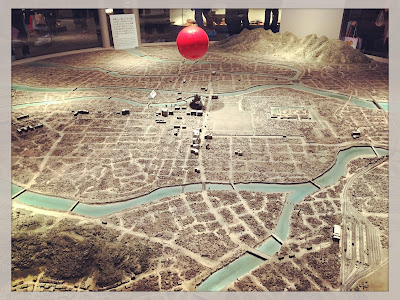Hiroshima is one of these cities that everybody heard of, and everybody associates it only with one event - first drop of the atomic bomb on 6 August 1945. During every trip, I'm trying to visit these historical sites, often witnesses of very painful events. I knew I couldn't miss Hiroshima while in Japan.
Hiroshima welcomed me with rain. Not a small shower I have already seen in Japan, but with a big, never-ending (or at least it seemed so) rain and a grey aura. At the exit from the station, I noticed an Information counter, so I asked about the way to my hotel. A very helpful lady explained me in a perfect (!) English the fastest way. My hotel turned out to be pretty far from the station, rather impossible to reach it on foot, so I took the streetcar (160 yen per journey). Far from the station, but very close from the Peace Memorial Park - a large park built in the city centre, which is a constant reminder of this tragic event, so despite the rain, I very much wanted to see it. That was it for visiting, in a nearby shopping centre I managed to find something decent to eat (Japanese!!).
The Flame of Peace still burning lightning despite the heavy rain. It is set to burn on until all the world's nuclear weapos are destroyed. Unfortunately I'm afraid it will be always burning...
Children's Peace Monument - built to commemorate a girl, who at the time of explosion was 2 years old, and nine years later she got a leukaemia. She believed that if she folds 1000 paper cranes (symbol of longevity and happiness in Japan), she would recover. Unfortunately before completing this task she died, but her classmates, and then other children from all the Japan and other countries kept on folding paper cranes. Plenty of them are around the monument, as well as in the whole Park.
Atomic Bomb Dome (or A-Bomb Dome) used to be the Hiroshima Prefectural Commercial Exhibition Hall. As the war intensified its role and functions were changed. The atomic bomb exploded approximately 600 meters above and 160 meters southeast of the building, ripping through and igniting the building, and instantly killing everyone in it. Although nearly all city got destroyed, the walls of this building survived. For many years it was discussed whether this building should be demolished or not. In 1966 it was decided to preserve it, and in 1996 the A-Bomb Dome was registered on the Unesco World Heritage List.
The next day - knowing that there's not that much to see and to do in Hiroshima - I enjoyed a long morning, and for the very first time in Japan, my own shower ;-) !!!
The 1945 bomb was dropped in the city centre and destroyed almost everything within a two kilometer radius. The city nearly stopped existing, and nobody believed it could be rebuilt. However these predictions turned out to be false. After the war huge efforts were made to rebuild the city, including some of the destroyed sites as Hiroshima Castle and Shukkeien Garden. I decided to visit these two places.
Hiroshima developed as a castle town, where the castle was physical and economical centre of the city, built in the sixteenth century, completely destroyed by the atomic bomb in 1945, and then rebuilt. The entrance is for free, but the castle is interesting only from the outside, there's nothing special inside.
Like in most sites I was visiting in Japan, I had to remove my shoes. In many of these places I was visiting barefoot, in the Himeji castle I was given these very stylish shoes ;-)
Shukkeien Garden was established in the seventeenth century, just after completion of Hiroshima Castle. It reminded me of other Japanese gardens, with one exception - the background. Shukkeien Garden really looked like an Oasis in the middle of concrete desert... It was completely surrounded by buildings, and it was difficult to forget I was in a big city...

After the Garden, I wanted to come back to the Peace Memorial Park. It was full of children - I guess it's obligatory for all Japanese schools to visit Hiroshima. One of the main sites in the Peace Memorial Park is Hiroshima Peace Memorial Museum. It not only introduces us to this historical and sad day, but is also holds a collection of items which belonged to people who were hit by the bomb, and photos. It was very striking to see how many of these items belonged to children (including teenagers who were working on that day - mobilized to demolish buildings for firebreaks), and how huge detriments it caused. It was incredible to see how in one second (?) a city ceased to exist and a big part of Hiroshima's habitants died (140 000 until December 1945, many more died after due to exposure to radiation).

And at the end of this day, I ate the best (so far) Japanese dish - Okonomiyaki - a sort of pancake friend with noodles, vegetables and meat. But in restaurant - Hassei - I could have my vegetarian option too - with cheese and eggs. Excellent and super yummy!






















No comments:
Post a Comment